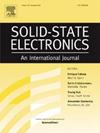Application of explainable AI on deep learning-based gate length scalable IV parameter extractor for BSIM-IMG
IF 1.4
4区 物理与天体物理
Q3 ENGINEERING, ELECTRICAL & ELECTRONIC
引用次数: 0
Abstract
A new deep-learning(DL) based gate length scalable I-V parameter extraction technique for FDSOI technology on industry-standard BSIM-IMG compact model is presented. For the first time, the learning quality of DL extractors has been studied using an explainable AI technique called SHapley Additive exPlanations (SHAP). Through analysis, it is shown that the single-step DL parameter extraction can get deviated by less relevant relationships between the region and the BSIM-IMG parameters. A multi-step DL extraction is then designed by applying expertise in BSIM-IMG model parameters. The multi-step DL extractor has a customized DL architecture that forces the DL model to learn the relevant relationship between the input datapoint and the BSIM-IMG parameters. The single- and multi-step DL extraction has been tested for measured data with gate-lengths () ranging from 52 nm to 961 nm. The multi-step DL extractor shows better accuracy in I-V and better scaling to the key electrical parameters as compared to the single-step DL parameter extraction. The developed solution has improved the accuracy, shortened extraction time, reduced the complexity, and can assist in very fast scalable model generation for FDSOI technologies.
可解释人工智能在基于深度学习的门长可扩展IV参数提取器中的应用
在工业标准BSIM-IMG紧凑模型上,提出了一种新的基于深度学习的栅极长度可扩展I-V参数提取技术。首次使用一种称为SHapley加性解释(SHAP)的可解释人工智能技术研究了深度学习提取器的学习质量。通过分析表明,由于I−V区域与BSIM-IMG参数之间的相关性较低,单步DL参数提取会出现偏差。然后利用BSIM-IMG模型参数的专业知识设计了多步深度学习提取。多步深度学习提取器具有自定义的深度学习架构,该架构强制深度学习模型学习输入ID数据点与BSIM-IMG参数之间的相关关系。对栅极长度(LG)从52 nm到961 nm的测量数据进行了单步和多步DL提取测试。与单步深度学习参数提取相比,多步深度学习提取器在I-V和关键电参数上具有更好的精度。开发的解决方案提高了准确性,缩短了提取时间,降低了复杂性,并且可以帮助快速扩展FDSOI技术的模型生成。
本文章由计算机程序翻译,如有差异,请以英文原文为准。
求助全文
约1分钟内获得全文
求助全文
来源期刊

Solid-state Electronics
物理-工程:电子与电气
CiteScore
3.00
自引率
5.90%
发文量
212
审稿时长
3 months
期刊介绍:
It is the aim of this journal to bring together in one publication outstanding papers reporting new and original work in the following areas: (1) applications of solid-state physics and technology to electronics and optoelectronics, including theory and device design; (2) optical, electrical, morphological characterization techniques and parameter extraction of devices; (3) fabrication of semiconductor devices, and also device-related materials growth, measurement and evaluation; (4) the physics and modeling of submicron and nanoscale microelectronic and optoelectronic devices, including processing, measurement, and performance evaluation; (5) applications of numerical methods to the modeling and simulation of solid-state devices and processes; and (6) nanoscale electronic and optoelectronic devices, photovoltaics, sensors, and MEMS based on semiconductor and alternative electronic materials; (7) synthesis and electrooptical properties of materials for novel devices.
 求助内容:
求助内容: 应助结果提醒方式:
应助结果提醒方式:


